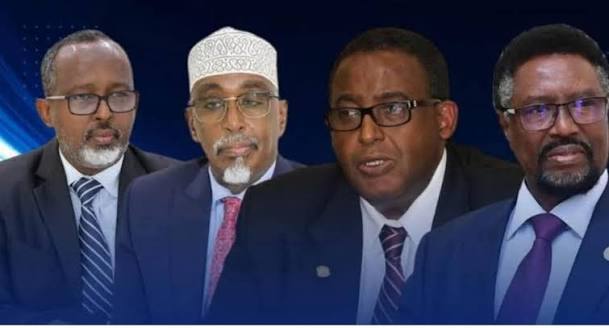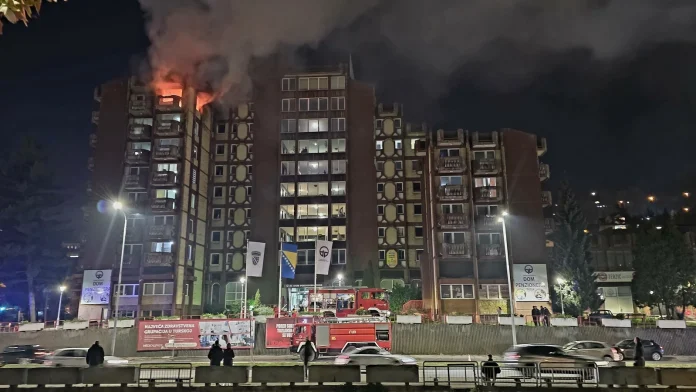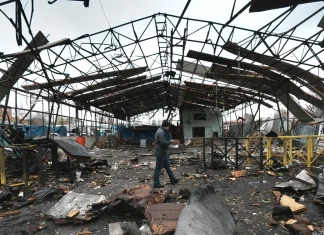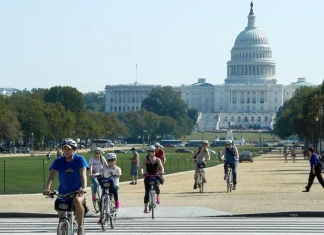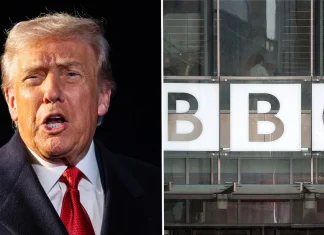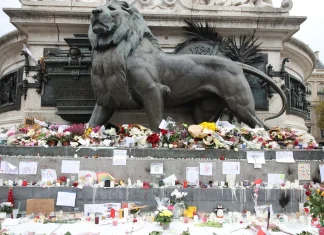Nov 05(Jowhar)-Isbaheysiga ay ku mideysan yihiin Cumar Cabdirashiid, Shariif Xasan Sheekh Aadan iyo 23 urur siyaasadeed ayaa si rasmi ah u soo jeediyay in doorashada Golaha Deegaanka dib loo dhigo muddo 30 maalmood ah.
Philippines Typhoon Death Toll Climbs Past 90 as Rescue Efforts Continue
When Streets Became Rivers: Cebu After Typhoon Kalmaegi
There is a strange, persistent sound in the hours after a flood: the low, haunted scrape of debris rubbing against concrete, the high thin chatter of people counting what’s left, and the long, wet sigh of communities trying to figure out how to begin again.
In Cebu — an island province typically known for its bustling markets, bright festivals and the scent of roasted lechon on the evening air — those everyday noises were drowned out by a different kind of ruin. Overnight, arterial roads became waterways, entire shanties clung to their foundations like seaweed, and hulking shipping containers rode the current like driftwood. By morning, the death toll from Typhoon Kalmaegi had climbed above 90 nationwide, with the hardest blow landing on Cebu: at least 76 lives lost there, the provincial toll reported by local officials.
On the Ground in Liloan and Beyond
In Liloan, a coastal town within the greater Cebu City metro area, rescue teams scraped mud from doorways and lifted sodden mattresses from alleys that, just a day earlier, had been rivers. Rhon Ramos, a provincial spokesperson, confirmed that 35 bodies had been recovered in flooded parts of Liloan — a grim number that became a stubborn fact for families waiting at evacuation centers.
“I thought our barangay had seen everything,” said a woman who runs a tiny sari-sari store tucked under a corrugated roof. “At four in the morning the water came like a wall. I could hear the metal gates bending, and then everything went.” She held a waterlogged ledger. “Everything is gone.” Her voice curled between disbelief and a tired, practical fury.
Outside the evacuation center, a man in mud-splattered jeans loaded a small generator into the back of a pickup while his neighbor handed him a battered wooden box. “The river overflowed,” he said. “We live by the bank because it was cheap. Now where do we go?”
Provincial Governor Pamela Baricuatro, describing the scene as “unprecedented,” told reporters the storm’s water — more than the winds — was the killer this time. The admission captured a new fear among local leaders: urbanization and fragile riverbank settlements can turn routine storms into calamities.
Numbers That Tell a Story
Some figures help frame the scale of the emergency. In the 24 hours before Kalmaegi’s landfall, weather monitors recorded 183 millimeters of rain around Cebu City — well above the area’s monthly average of 131 millimeters, according to weather specialist Charmagne Varilla. Nearly 400,000 people were moved out of harm’s way in advance of the storm, a major logistical effort that likely saved many lives even as it underscored the vulnerability of dense coastal and riverside neighborhoods.
The Philippine military, mobilised to assist relief efforts, also suffered a tragic loss: a Super Huey helicopter on a relief sortie crashed on northern Mindanao, near the city of Butuan. Authorities later recovered the remains of six servicemembers. The Eastern Mindanao Command confirmed the helicopter was en route to support operations when it went down.
Voices from the Flood
“I’ve fished these waters my whole life,” said an elderly fisherman, pulling a bent net from a mucky pile. “This is the worst I’ve seen. The sea was angry, and it wasn’t just the sea — the rivers came out of their beds.” His hands trembled as he described the night, and he shook his head at the sight of a metal shipping container jammed awkwardly against a row of coconut trees.
A young volunteer from a local church, boots caked with mud, described the scale of humanitarian need: “People need dry clothes, baby formula, medicines for the old people. It is more than shelter — it’s the dignity that the flood washed away.”
Experts watching from Manila and abroad are reluctant to dismiss the fury of Kalmaegi as a standalone event. “We are seeing a pattern where storms intensify faster and dump more rain because ocean temperatures are higher,” said a climate scientist I spoke with, asking for anonymity to speak candidly about attribution. “A warmer atmosphere holds more moisture. That increases the risk of these sudden, catastrophic floods in coastal, urban—and poorer—neighbourhoods.”
Not Just a Local Tragedy: A Global Pattern
Kalmaegi is part of a troubling trend. The Philippines averages about 20 tropical cyclones a year; this storm brought that yearly tally to the expected average, and meteorologists said another three to five systems could still form before the end of the season. In recent months the country has already grappled with other major storms, including Super Typhoon Ragasa in September.
Globally, scientists point to warmer seas and atmosphere as contributors to storms that are more intense and more moisture-rich. The result is straightforward but devastating: heavier downpours in a shorter time, compounded when communities live in flood-prone corridors that have been squeezed by rapid urban growth.
Immediate Needs and the Road to Recovery
On the ground, the priorities are painfully clear:
- Search and rescue for the missing;
- Medical care for injuries and prevention of waterborne disease;
- Emergency shelter, dry clothing and food for displaced families;
- Restoration of power, water and communication links.
Relief organizations are setting up temporary kitchens and medical tents. Local government units are creating lists of families who have lost their homes. Volunteers are coordinating with the military for debris clearance and distribution of aid supplies. Yet logistical bottlenecks and damaged roads make each step uphill.
What Does “Resilience” Really Mean Here?
When will rebuilding stop being a patchwork response and become a chance to design for a different future? That question hangs over Cebu as clearly as the soggy laundry lines strung between battered posts.
“Resilience cannot be just a word we use when the water recedes,” said an urban planner with experience in post-disaster reconstruction. “We need to look at zoning, at river management, at affordable housing away from floodways. We need community-centered planning that understands how people actually live.” She paused. “Otherwise, every storm will just reveal the same gaps.”
It’s a difficult conversation: relocate people who have lived by the river for generations? How to balance livelihoods tied to place against the safety of families? How to fund large-scale infrastructural change in a country where millions still live in poverty?
After the Waters, a Call to Reflection
As Cebu cleans its streets and tallies its losses, the human texture of the disaster refuses to be reduced to statistics. There are names behind each number: grandparents who kept their grandchildren safe at the cost of their own lives, shopkeepers whose tiny savings have been swept away, volunteers who will not sleep until the last displaced neighbor has a blanket.
What do we want our communities to look like after the next storm arrives? Who bears the cost when climate risk meets poverty? These are not questions for distant committees alone; they are urgent, local, and moral. They demand investment, political will and — perhaps most importantly — the involvement of the people who know their neighborhoods best.
For now, residents of Cebu and surrounding provinces are in the slow work of recovery: sorting, salvaging, consoling, and remembering. If there’s any comfort, it is in the long Filipino tradition of bayanihan — the spirit of communal help — which is visible now in the volunteers handing out warm bowls of soup, in neighbors ferrying elderly people to safety, and in strangers who have become temporary kin.
As you read this, consider how far-reaching the consequences of a single storm can be. If climate change is reshaping the way disasters unfold, then our responses must change too — fast, fairly, and with deep respect for the people who live with the consequences.
Muslimkii u horeeyay oo ku guuleystay duqa magaalada New York
Nov 05(Jowhar)-Musharraxa xisbiga Dimuquraadiga Zahran Mamadaani, ayaa ku guuleystay doorashada jagada duqa magaalada New York ee Mareykanka.
Police: Ten die in nursing home fire in Bosnia
Flames in the Night: A Bosnian Nursing Home That Never Slept
On a cool evening in northeastern Bosnia, the ordinary rhythm of a care home was shattered by a sound no one wants to hear: a crack, a rush of smoke, then panicked voices. By the time dawn timidly eased over Tuzla the next morning, 10 residents lay dead and nearly 20 people — residents, staff, firefighters and police — were receiving treatment at the Tuzla University Clinical Centre. What began as a place of shelter and quiet routines turned into a scene of chaos and grief.
Witnesses in Pajamas
“I thought someone was dropping heavy dishes,” said one resident who escaped down the stairwell and asked to be named only as Jasna. “Then the whole corridor filled with smoke. We grabbed what we could — slippers, a blanket — and ran. On the upper floors there were people who couldn’t move. I could hear them coughing.” Her voice, hoarse from the night, trembled as she spoke about the helplessness of watching neighbours — some bed-bound — as flames licked through the building.
Local television footage showed a portion of the care home’s upper floor engulfed in orange light, embers drifting like strange, burning snow. Fire crews worked into the night, their helmets gleaming under searchlights, hoses snaking across the asphalt. Officials later said the blaze began on the seventh floor at about 8:45pm local time and was brought under control, but not before lives were lost.
First responders and survivors
“We did everything we could for those inside,” a firefighter on the scene told me, his soot-streaked face under a beanie, hands still shaking. “You always dread the worst in places like this: limited exits, mobility-impaired residents. It tests you.” The fire department has been credited with containing the blaze, yet containment came after a toll that will be felt for many months — and likely years — by a small community that knows one another’s birthdays and coffee habits.
The Human Geography of Loss
Tuzla, a city of salt pans and chimneys, is a place shaped by industrial labour and communal ties. In neighborhoods where people exchange home-brewed plum rakija and morning cups of thick Bosnian coffee across shared balconies, news like this lands hard. The nursing home was not a faceless institution; it was a mosaic of lives—former teachers, miners, mothers, fathers—each with stories that will now be recounted at funeral tables and memory gatherings.
“We are devastated,” said a small business owner who used to visit his father weekly at the home. “These were our elders. They taught us songs and recipes. What do you say at a wake when everything comes too soon?” His hands rested on a rusting storefront counter as he tried to collect himself. Around him, neighbours moved quietly, eyes rimmed in red.
Official Response and an Unfinished Investigation
Bosnia’s tripartite presidency acknowledged the tragedy, offering condolences to grieving families while government officials vowed a thorough probe. The prime minister called the event a “disaster of enormous proportions,” words that conveyed both grief and the weight of responsibility.
Police have said a full forensic investigation will proceed when conditions allow. That will focus on cause and, likely, the procedures in place for a residence with vulnerable people. Was there a working alarm system? Were evacuation routes adequate? Were staffing levels sufficient that night? These are not just bureaucratic questions — they are the ones families will want answered before they can find closure.
Questions that linger
- How well-equipped are care homes in Bosnia and Herzegovina to prevent and respond to fires?
- Are regulations for elder-care facilities enforced uniformly across regions?
- What resources do emergency services have in smaller cities like Tuzla, and has regional funding kept pace with needs?
Behind the Headlines: Broader Fault Lines
Tragedies like this are not isolated. Globally, fires in residential care settings are particularly deadly because residents often have limited mobility and chronic health conditions that make rapid evacuation difficult. In countries with aging populations, the question is as much about infrastructure and investment as it is about compassion. Bosnia faces additional challenges: post-war infrastructure gaps, strained social services, and a healthcare system that often juggles emergencies with limited budgets.
“This is a wake-up call,” said an independent fire-safety consultant who reviewed the available information and spoke on condition of anonymity. “You need clear evacuation protocols, regular drills, up-to-date alarm systems, and training tailored to residents who cannot ambulate independently. Otherwise, the odds stack against them in a fire.” His voice was measured, but the urgency came through. “Prevention is cheaper and less painful than response.”
Small Rituals That Bind a City
Walk through Tuzla and you’ll see the everyday rituals that make loss communal. Shopkeepers sweep the same front steps they did last year; pensioners gather under plane trees to swap gossip and morning coffee; the old sevdalinka singers can still be heard at neighborhood cafés, a melodic reminder of resilience. These small acts — the shared cigarette behind a bakery, the habit of borrowing sugar — are now the social scaffolding that will support grieving families.
“We will remember them when we sit down to coffee,” said an elderly neighbour, smiling through tears. “When the next winter comes and we bring flatbread to each other, their names will be there. That’s how we keep them near.” There is a simple dignity in that: remembrance through routine.
What Comes Next?
The immediate priorities are clear — care for the injured, counselling for survivors and families, and a transparent investigation. But there is a longer arc to consider. Will this tragedy spur policy changes? Will funding shift to fortify vulnerable care facilities across Bosnia and Herzegovina? Will families be reassured that loved ones in institutional care are safe?
Readers far away might ask: why should the fire in a Tuzla nursing home matter to me? Perhaps because the questions it raises — about aging, dignity, and public responsibility — are global. Across continents, societies are grappling with how to honour older adults without placing them in peril. How we respond, here and now, says a lot about what we value.
Closing: A City Mourns, A Country Watches
In the days ahead, Tuzla will set out tables for condolences, the clergy will visit rooms where flowers gather, and neighbours will string lights as a small, human defiance against the dark. Investigators will take their time. Families will demand answers. And in the quiet hours, someone will make coffee for two, one cup for a person now gone, and one for memory.
What do we owe our elders? Is it enough to offer shelter if we cannot ensure safety? These are the questions this tragedy leaves us with — questions that linger long after the smoke clears.
Prime Minister’s Office Confirms Israel Received Remains of Gaza Hostage
A coffin, a convoy and a city that refuses to sleep: life at the margins of a fragile truce
When the Red Cross truck rolled up to the perimeter last week, there was a hush that felt more like waiting than relief. Men in army fatigues checked manifests. A small team from the Shin Bet clipped ribbon; a medic adjusted gloves. For families watching from across the barrier, the moment carried the complicated taste of closure and the unbearable salt of confirmation.
“You don’t get to think ‘closure’ in one breath,” said Miriam Adler, whose nephew remains listed as missing. “There is a story inside that casket, and for us the story keeps changing its ending.” Her voice trembled and steadied in the same sentence — a cadence familiar to anyone who has learned to live with grief that can be interrupted by bureaucracy, by politics, by the cadence of a ceasefire.
What happened — and what it reveals
Under the US-mediated ceasefire that began on 10 October, one of the most wrenching clauses was the return of all hostages, dead or alive. In recent days, Israeli authorities announced they had received the remains of a hostage via the Red Cross; Hamas’s armed wing, the Ezzedine Al-Qassam Brigades, confirmed it had recovered a body in Shujaiya while excavating under the so-called “yellow line” that marks Israeli positions inside Gaza.
If confirmed, this would be the 21st deceased hostage handed over since the truce took effect. At the start of the agreement, Israeli tallies indicated Hamas held 48 hostages — 20 alive and 28 presumed dead. The living have since been released; the dead continue to be brought back piecemeal, a painful accounting that refuses neatness.
Voices from both sides
“We are working to complete the entire exchange process as soon as possible,” Hazem Qassem, a Hamas spokesman, told local media, acknowledging the practical difficulties: many bodies are entombed beneath collapsed buildings, sometimes weeks or months after strikes.
An official from Israel’s Prime Minister’s office was blunt: “Every returned life—or body—is a matter of national and moral urgency.” In a later statement the military said the remains had been transported to a forensic medical centre for identification, the next step in a procedure that blends science, dignity, and ritual.
Shujaiya: where excavations find more than concrete
The neighborhoods of Gaza carry stories the way old books wear fingerprints. In Shujaiya, piles of rubble are layered like sedimentary memory: apartment blocks, makeshift shops, a school with a partially intact mural. “We are digging for everyone,” said Ahmad al-Saleh, a local volunteer. “We find shoes, toys, a piece of a wedding dress — and sometimes, a person.” His hands are calloused from sifting through dust and metal; his voice has the calm of someone who has learned to compartmentalise trauma so that work can continue.
Search operations are slow, dangerous and painfully human. The militants say they need heavy machinery and more personnel to reach bodies under collapsed structures. Their critics accuse them of delaying returns for political leverage. The truth likely lies in both: a battlefield’s devastation complicates every administrative and humanitarian act.
Numbers that won’t let us look away
Statistical tallies are blunt instruments in a messy human story, yet they matter. Israeli officials attribute 1,200 deaths to the 7 October cross-border attack, and 251 people were taken hostage, according to Israeli figures. Palestinian health authorities in Gaza report the Israeli retaliatory campaign has killed more than 68,000 Palestinians; the figures diverge in methodology and meaning, but the arithmetic of loss is undeniable.
Since the truce, the United Nations’ World Food Programme says it has delivered food parcels to roughly one million people in Gaza, and aims to reach 1.6 million. Some 700,000 people now receive fresh bread daily thanks to WFP-supported bakeries. Yet, as Abeer Etefa, the WFP’s Middle East spokeswoman, warned in Geneva, “We are in a race to save lives.” The logistical obstacles — closed crossings, damaged roads, limited distribution points — mean that agency capacity is still only half of what’s needed.
The texture of scarcity
Walk through Khan Younis and you’ll see that aid is changing daily rhythms. Bakeries that once produced loaves in sleepy shifts now crank out round-the-clock bread for hundreds of thousands. “An apple costs what a kilo cost before the war,” said Nour Hammad, WFP’s spokeswoman in Gaza — a small sentence that collapses a lifetime of markets, kitchens, children’s lunches into a single, devastating price point.
Households are coping by reverting to staples: cereals, pulses, bread. Meat, eggs, fresh fruit — luxuries in a landscape where aid trucks are a lifeline and commercial supplies are often priced beyond reach. The limited crossings open — Kerem Shalom and Kissufim — mean that the north of Gaza remains especially vulnerable.
Small moments, large questions
In a makeshift clinic, a nurse named Fatima tied a scrap of cloth around a child’s arm like a tiny flag. “We do what we can,” she said. “We stitch, we feed, we listen. But sometimes the small things are not enough.” Her clinic is crowded, warm with the smell of antiseptic and the soft insistence of children’s breathing. Outside, a queue of people waits for parcels — a line that hints at dignity and dependence at once.
What does it mean when recovery requires not only ceasefires but cooperation from those who fought? What happens when humanitarian agencies plead for access and are met with silence about why northern crossings remain closed? These are not rhetorical questions for those living in Gaza and southern Israel; they are determiners of life and death.
Where to from here?
The exchange of bodies is painful work — forensic, diplomatic, ritual. Each returned person compels a country to mourn, and a community to reckon. Each day that aid does not reach vulnerable populations lengthens the shadow of the emergency.
For readers far from the border, this conflict asks us to hold two things at once: the urgency of immediate humanitarian needs, and the long shadow of geopolitical patterns that make ceasefires and aid corridors repeatedly necessary. What responsibilities do we carry as global citizens when aid deliveries are stalled, when families await the identification of loved ones, when bakeries become lifelines?
We can start by listening — not to headlines alone, but to the small, fierce voices on the ground: the medic, the volunteer, the mother who insists on naming a child even as a city is un-named by destruction. “We are not numbers,” Ahmad said as he sifted through rubble. “We are stories.” These stories are what remain when bullets and politics recede: messy, surviving, insistent. They are what must shape our response.
UN warns global temperatures set to exceed 1.5°C Paris target
A planet nudging past a line we promised to keep
On a muggy morning in Belém, the river smells like wet wood and citrus. Vendors at the market haggle over tucupi and tapioca while teenagers paint cardboard placards for the climate march. For all the rhythm and color of daily life, there is an undercurrent of unease: scientists say the global thermostat is about to tick over a limit that once felt, politically and morally, untouchable.
Last week’s United Nations Environment Programme Emissions Gap report reads like a ledger of promises postponed. The stark conclusion — the world has effectively missed its primary 1.5°C target under the 2015 Paris Agreement and will likely exceed it within the next decade — landed on laptops and newsfeeds with the thud of a wake-up call.
“This will be difficult to reverse,” the UN said. “It would require faster and bigger additional reductions in greenhouse gas emissions to minimize overshoot.” Anne Olhoff, the report’s lead author, put it in plain language: deep cuts now could delay the overshoot, “but we can no longer totally avoid it.”
Numbers that don’t lie (and won’t be ignored)
Concrete figures sharpen the picture. Governments’ current pledges — if fully implemented — still steer the globe toward roughly 2.3–2.5°C of warming by century’s end. Under policies already on the books, the projection is worse: about 2.8°C. Carbon pollution rose again in 2024, increasing by 2.3% to an estimated 57.7 gigatonnes of CO2 equivalent. Ten years after Paris, the world has made progress — a once-feared pathway toward 4°C warming has been narrowed — yet the remaining gap is still vast.
We should not treat these decimals as abstract. Each fraction of a degree translates into livelihoods, landscapes, and lives: at 1.5°C, at least 70% of coral reefs would be destroyed; at 2°C, that figure climbs toward 99%. Heat stress, drought intensity, and wildfire potential all climb nonlinearly. As the UN succinctly reminds us: every fraction matters.
From pledges to practice: promises on paper, emissions in the sky
It is tempting — and comforting — to pin hope on the announcements that made headlines this year. China, the world’s largest CO2 emitter, pledged in September to reduce emissions by 7–10% from their peak by 2035. Analysts note a pattern: Beijing often sets modest official targets and then exceeds them. Still, when you add up competing national ambitions, the sum still falls short.
“We are seeing some policy traction,” said Dr. Maya Alvarez, a climate policy analyst who has worked with governments in Latin America. “But traction is uneven. Energy transitions are racing ahead in parts of Europe and certain Asian economies, while coal plants are still being built and fossil fuel subsidies remain entrenched elsewhere. That disconnect is why the gap persists.”
Local voices in Belém echoed that mix of resolve and frustration. “We can see the river level changing in ways our grandparents never described,” said José Carvalho, a fisherman who depends on seasonal tides and predictable rains. “We hear promises on the news, but when the rain arrives too early or too late, the fish are gone. My son asks me if there will still be mangroves to play in. I don’t have a good answer.”
What COP30 has to wrestle with
All of this adds pressure to the upcoming COP30 summit, where diplomats, ministers, activists and business leaders will try to translate the gap into urgent action. Conversations will not be limited to emissions curves: they will include financing for adaptation and loss and damage; mechanisms for technology transfer; and the geopolitics of energy — who phases out fossil fuels, who accelerates renewables, and who pays for the transition.
“COP is the place where the political will should be forged into operational plans,” said Sindre Halvorsen, an energy transition advisor. “But willingness without finance is a species of rhetoric. Developing nations need predictable financing to protect their people now and to leapfrog dirty infrastructure.”
Human stories in a global ledger
Statistics are necessary; stories change minds. Consider the coral reefs of the Caribbean and the fishers who rely on them. An underwater scientist I spoke with on a recent field trip described reefs as cities of the ocean—bustling, fragile, irreplaceable. “At 1.5°C, we’ll still lose most of this neighborhood,” she said. “At 2°C, it’s essentially bulldozed. That’s not a slogan. It’s a way of life disappearing.”
Across the Sahel, pastoralists trace shifting grazing patterns; in Pacific atolls young families measure their days against saltwater intrusion. In cities, hospital emergency departments brace for more heat-related admissions each summer. The damage is not evenly distributed. Those least responsible for emissions often bear the worst of the consequences.
Choices ahead — and what they cost
Overshoot is not a sentence so much as a challenge. It opens a brutal math problem: either we accelerate emissions cuts harder and faster than history has shown we can, or we accept a period where temperatures exceed desired thresholds and invest heavily in adaptation and carbon removal technologies to pull them back down later.
Both paths have costs. Faster decarbonization requires political courage: eliminating subsidies for fossil fuels, upgrading grids, retrofitting buildings, and rapidly scaling renewables and storage. Overshoot-plus-removal bets on nascent technologies like large-scale carbon capture, bioenergy with carbon capture (BECCS), and enhanced weathering — all costly and unproven at the scale required.
- Short-term acceleration: immediate cuts, faster renewables, demand reduction.
- Managed overshoot: temporary overshoot followed by engineered removal of CO2 from the atmosphere.
- Adaptation-heavy: accept higher temperatures and invest massively in resilience.
What can a single reader do?
It’s easy to feel small. But history shows that small actions, multiplied, can shift policy and markets. Pressure matters: voters, consumers, investors and activists together alter the economics of energy and the calculus of governments. Here are practical levers:
- Demand accountability: ask candidates how they will fund rapid decarbonization and protect vulnerable communities.
- Shift investments: support banks and funds that prioritize clean energy and divest from high-emission projects.
- Adapt behavior where feasible: reduce waste, fly less, use public transit or electric mobility.
- Support local adaptation: back community-led initiatives that protect coasts, rebuild wetlands and strengthen food systems.
How will we be remembered?
We stand at a pivot. The next decade will define how much of the planet’s richness is preserved for our children. Will we be the generation that turned grudging agreements into a global sprint? Or the one that told ourselves we tried and then watched the ledger tilt?
“The science doesn’t leave room for complacency,” Olhoff told reporters. “Delay makes the math steeper. It makes the political choices harder and the costs bigger.” The question the world — and you, as a reader — must wrestle with is simple and brutal: what price do we assign to patience?
In Belém the marchers gather, voices threading through the humid air: teachers, students, elders, fishermen, and doctors. They do not chant numbers; they chant futures. If the Emissions Gap report is a ledger of failures so far, let it also be a ledger of accountability, one that the world can still balance if we choose to act with speed, fairness, and imagination.
Former U.S. Vice President Dick Cheney Passes Away at 84
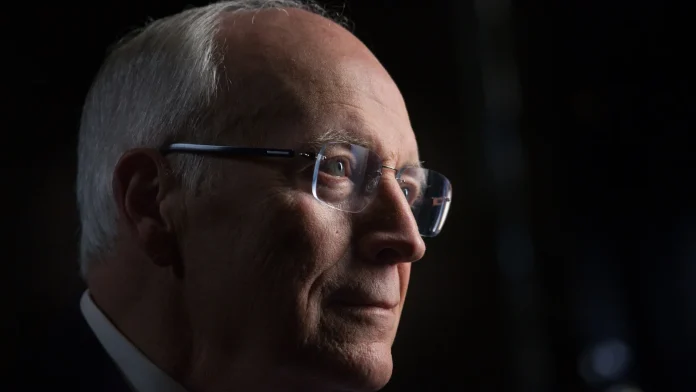
A Quiet Life, A Stormy Legacy: Remembering Richard B. Cheney
Richard “Dick” Cheney died last night at 84, his family said, succumbing to complications of pneumonia and longstanding cardiac and vascular disease. The short statement that accompanied the news captured a private tenderness that often sat oddly beside the public ferocity of his years in power: “a great and good man who taught his children and grandchildren to love our country, and to live lives of courage, honor, love, kindness, and fly fishing.”
It is a final image that feels quintessentially Cheney — an angler’s calm, a family vignette — set against a public life that reshaped the American presidency and altered the course of the early 21st century.
From Plains to Power: The Making of a Vice President
Born in Lincoln, Nebraska, on January 30, 1941, Cheney’s life was a long arc from the wide skies of the American West to the narrow corridors of Washington. He moved to Wyoming as a child, worked with his hands on power lines and coal plants in his twenties, and returned to school at the University of Wyoming to finish degrees in political science. Even his return to politics had the feel of a Western tale — practical, stubborn, uncompromising.
“He had the plainspoken look of someone who’d spent winters in a wind and summers in a trout stream,” said a long-time neighbor from Jackson Hole. “But that didn’t make him any less formidable in a room.”
Cheney’s résumé reads like a map of modern Republican governance: congressional staffer, White House operative under Nixon and Ford, member of the House for a decade, Secretary of Defense under George H. W. Bush, CEO of Halliburton, and then — the decision that cemented his place in history — George W. Bush’s choice as running mate in 2000. He served as the 46th vice president from 2001 to 2009, guiding a vice-presidential office that many argue was transformed into a second center of power.
The Power of the Office
Cheney believed the presidency had been diminished after Watergate and made it a mission to rebuild executive strength. He assembled an inner national security team that often operated as a government within the government, a configuration that thrilled some allies and alarmed many critics.
“He wasn’t interested in ceremonial roles,” said a former administration official. “He wanted an engine. He wanted to run the engine.”
That engine revved fastest after September 11, 2001. In the months and years that followed, Cheney became one of the administration’s most ardent voices for preemption and for aggressive counterterrorism measures. His advocacy fed decisions that would reverberate across the globe and for generations of Americans.
Iraq, Intelligence and Controversy
Perhaps nothing illustrates Cheney’s imprint more starkly than the 2003 invasion of Iraq. He was an unrelenting advocate for war, arguing that Saddam Hussein possessed weapons of mass destruction and posed a direct threat to the United States. History now records that the WMDs were not there; intelligence assessments that had been used to justify the invasion were later found to be flawed.
“He truly believed the intelligence he was given,” said an academic who has studied the era. “Even when the facts on the ground didn’t match the premises, he stayed resolute.”
The human cost of that conflict is measured in complex, contested numbers: more than 4,400 U.S. service members killed, thousands more wounded, and civilian toll estimates that range widely, with some studies suggesting hundreds of thousands of Iraqi deaths from violence and the wider collapse of infrastructure.
Cheney’s tenure is also closely linked to a darker debate about methods. The administration authorized “enhanced interrogation techniques” — waterboarding, sleep deprivation, stress positions — measures that the U.S. Senate Intelligence Committee and many international human-rights bodies later described as torture. Supporters said they were necessary for national security; opponents called them a moral and legal breach that damaged America’s standing in the world.
“We were at war and we did what we had to do,” Cheney told an interviewer years later. “History will judge.”
Industry, Influence and the Personal
Between stints in government, Cheney spent five years at Halliburton and left with a retirement package reported at roughly $35 million. Halliburton subsequently became a major contractor in Iraq, a fact critics seized on as proof of cronyism and tangled motives. Supporters countered that Cheney’s decisions were driven by national security concerns, not private gain.
Politics, however, was never divorced from the personal. Cheney’s family life — his long marriage to Lynne, his daughters Liz and Mary — often attracted as much attention as policy memos. Liz Cheney emerged as a hawkish Republican congresswoman, eventually breaking with her party’s dominant faction to oppose Donald Trump — a move that cost her politically but reinforced a public image of principled contrarianism.
“He taught us to reason from principle,” said Liz Cheney in a speech in the wake of the Capitol attack on January 6, 2021. “Even if the price is high.”
That price was real. Her political fortunes suffered after she voted to impeach Trump, and the father-daughter alignment on certain issues — including Cheney’s later public denunciations of Trump’s threat to democratic norms — made their household a flashpoint in modern conservative politics.
Health, Humor and the Public Image
Cheney’s body had often betrayed him. He suffered his first heart attack at 37, battled chronic cardiac problems throughout his life, and in 2012 received a heart transplant. He became, in his later years, an unmistakable public figure: bald, blunt, frequently mocked by late-night comedians who compared him to Darth Vader — a comparison Cheney sometimes laughed off. Once, he even wore the villain’s mask on a talk-show stage as a piece of theatrical self-mockery.
“If people want to call me Darth Vader, that’s fine,” he quipped once. “I’ll take the dark suit.”
He had lighter infamy too: the hunting accident in 2006 when he accidentally shot his friend Harry Whittington — a story that became a staple of late-night jokes and political cartoons.
How Should We Remember Him?
There are two converging images in the obituary of Dick Cheney: the quiet fisherman who loved fly fishing and family dinners, and the hulking architect of a more muscular — and more controversial — executive power. Both are true, and both are inadequate on their own.
What do we do with leaders whose actions were consequential but deeply contested? How do societies balance national security and human rights, vigilance and restraint? These are not academic questions but living arguments that play out in parliaments and courtrooms, in veterans’ hospitals and in the surveillance of everyday life.
“He changed how people think about power in the presidency,” said a historian of American politics. “Whether that change is judged wise or ruinous depends on what you value most.”
As the global community takes measure of Cheney’s life and legacy, it is worth pausing not only to tally policies and casualties, but to remember the human contradictions: the man who loved his country and his grandchildren, who championed a robust defense and endorsed tactics others called torture, who could be tender about fly rods and merciless in meetings.
In the end, his family asked that memories be of courage, honor and kindness. The public will have its own ledger. For readers around the world — many of whom felt the reverberations of Washington’s decisions in their own streets — the question remains: how will history balance the private and the political, the creeks where he fished and the deserts where soldiers fought?
Catch the Beaver Moon Tonight: Stargazers Set to Spot It
Tonight’s Moon Isn’t Just Full — It’s a Moment
Look up. If the sky is clear where you are, the moon will be a little closer, a little brighter, and a touch more commanding than usual — a silver coin pinned to the night. Over the next couple of nights, including tonight through Thursday night, stargazers around the world will be treated to the year’s most dramatic supermoon, known in many North American traditions as the Beaver Moon.
“You can feel it in the way people slow down,” said Dr. Elena Morales, an astronomer at the Royal Astronomical Society. “Even in a city where the stars are few, the moon still reaches us. A supermoon is a good excuse to step outside and remember we’re all under the same sky.”
What Makes a Supermoon Special?
Technically, a supermoon happens when a full moon coincides with the moon’s perigee — the point in its elliptical orbit when it is closest to Earth. Put simply: the sun, Earth and moon line up, and the moon sits nearer us than usual.
That closeness translates into real, measurable differences. NASA and other observatories explain that a typical supermoon can appear up to about 14% larger and as much as 30% brighter than the smallest, farthest full moons. The moon won’t suddenly double in size. But when it’s near the horizon and framed by familiar foregrounds — a church spire, a stand of pines, a rooftop — that increase can feel cinematic.
Average lunar distance is roughly 384,400 kilometers. At perigee, the moon might be nearer to around 357,000 kilometers. Those numbers wobble a bit from month to month, but they’re enough to make a noticeable difference, especially through a camera lens or a good pair of binoculars.
What to Expect This Week
The full moon will be visible across multiple nights — one of the conveniences of a skywatching weekend. Observers in North America, Europe, parts of Africa and Asia can catch the moon when it climbs the evening sky, while late-night viewers in other regions will also have opportunities. Cloud cover, local weather, and light pollution will be the deciding factors.
“Even a thin veil of clouds can make the moon glow like a watercolor,” said amateur astronomer Priya Shah, who runs a neighborhood stargazing group in Toronto. “But if you want sharp detail — the maria, the craters — aim for a clear, dry night and find an elevated spot away from streetlights.”
The Story Behind the Name: Beaver Moon
Names for full moons are threaded through cultures and seasons. The “Beaver Moon” is one of those time-honored names that comes from Native American and early colonial agrarian calendars; it arrived in common parlance through sources like the Farmers’ Almanac and references to Algonquian language traditions. For many Indigenous communities, the name signaled a time when beavers were active and trappers set their final traps ahead of winter, when woodcutting, food stores and shelter had to be secured.
“These names are ecological markers,” said Dr. Naomi White, a scholar of Indigenous studies. “They connect human lives to animal cycles, weather patterns and the lived knowledge of people who have been watching the sky for generations.”
It’s a beautiful reminder: the calendar in our heads isn’t just numbers. It’s weather, migration, harvest, and ritual — a map of how communities related to the land and sky before modern timekeeping made everything abstract.
How to See — and Photograph — the Supermoon
Whether you’re a casual looker or a determined shooter, the moon is forgiving. Here are some tips drawn from photographers and skywatchers:
- Find a foreground. Trees, buildings, and people give scale and soul to lunar photos.
- Use a telephoto lens (200–600mm) or binoculars to make the moon’s features pop.
- Stabilize: a tripod or leaning against a steady surface will reduce blur.
- Camera settings: start around ISO 100–400, aperture f/8, shutter speed 1/125–1/250. The moon is bright — slower exposures will wash out detail.
- Try the “moon illusion”: photograph when the moon is low on the horizon to make it feel enormous, even though it’s the same size later on.
“I always tell people: don’t only shoot for the internet’s sake,” Priya Shah said. “Try to take one picture and then just sit and look. Your eyes will appreciate the experience more than any lens.”
Light Pollution, Cultural Moments, and Quiet Reflection
There is another thread running through this small astronomical event: the steady encroachment of light pollution. Studies in recent years have estimated that a substantial majority of people on Earth now live under skies brightened by artificial light — enough that the Milky Way is invisible to much of the global population. Still, the moon’s brightness can cut through city glare and remind urban residents what a true night feels like.
For others, the moon intersects with local customs. In East Asia, autumn moon-viewing festivals have their own rituals; in Turkey and across the Muslim world, moon sightings mark important calendar moments. In fishing communities, moon phases are woven into the practical rhythms of tides and nets. The Beaver Moon carries a whisper of all those connections.
“I check the moon before I check the weather,” said Jonas Petrov, a lobsterman in coastal Maine. “Tides change, but the moon tells you something about the rhythm. Folks like me still time things by that old knowledge.”
Why It Matters — More Than a Pretty Photo
On one level, tonight’s sky is a simple offering: a luminous companion to our brief lives on a blue planet. On another, it’s a chance to reconnect. We live in an era of constant information and often-compartmentalized time; a supermoon asks us to pause collectively. It becomes a public event you can experience without an app, a place where amateurs and astronomers meet on equal footing.
So, will you step outside tonight? Will you pull a blanket over your knees, pause a busy evening, or drag your partner out of a meeting so you can both watch the earthlight spill across the same face of the moon that sailors, farmers, and storytellers have watched for millennia?
If you do, you’ll be taking part in a quiet, ancient ritual — and you might just remember how small our everyday anxieties look beneath a brilliant, borrowed sun.
Madaxweyne ku-xigeenkii hore Maraykanka Dick Cheney oo geeriyooday
Nov 04(Jowhar)-Madaxweyne ku-xigeenkii hore ee Maraykanka Dick Cheney ayaa u geeriyooday cudurka oof-wareenka (pneumonia) iyo cudurrada wadnaha iyo xididdada dhiiga isagoo 84 sano jir ah.
Millions of Americans Face Reduced Food Aid During Government Shutdown

When the Lights Flicker: Groceries, Courts, and the Human Cost of a Shutdown
On a cold Saturday morning beneath the fluorescent hum of a supermarket in downtown Providence, a volunteer in a bright orange vest handed a trembling woman a folded flyer. The woman — two toddlers clinging to her coat — read it as if it were a weather alert. “SNAP guidance: partial payments,” the flyer said, in small print that felt shockingly large in the quiet aisle.
That folded piece of paper is where policy meets pantry. Behind the legal filings and headline-grabbing tweets, tens of millions of Americans are now recalculating how to feed their families while politicians trade ultimatums. The government shutdown — inching toward what would be the longest in U.S. history — has forced a wrench into the nation’s safety net, leaving about 42 million people who rely on the Supplemental Nutrition Assistance Program (SNAP) watching the grocery cart instead of the calendar.
How we got here — and who’s holding the checkbook
Late last week, federal judges in Rhode Island and Massachusetts told the White House to dip briefly into a $4.65 billion emergency fund to cover part of SNAP’s November bills — a stopgap amid a deeper $9 billion tab. But the Department of Agriculture, which runs SNAP, told a federal court in Rhode Island it would not make up the difference with other pots of money, meaning only roughly half of recipients’ usual benefits would be disbursed.
The arithmetic is brutal. SNAP benefits average about $356 per household each month. For many families, that figure is the difference between a full cart and a week’s worth of instant noodles. With payments lapsed, as one official put it, “people don’t ask: where will I sleep? They ask: where will my children get dinner?”
At stake beyond SNAP are related programs such as WIC — the Special Supplemental Nutrition Program for Women, Infants, and Children — and Head Start services that wrap nutrition into early childhood support. Many local programs began shuttering or curtailing services as federal assurances faded.
Voices from the line
“I stood in line and watched people hand back cartons of milk,” said Maria Lopez, a food pantry coordinator in a working-class neighborhood outside Providence. “This is not charity theater. This is people’s lives.” Her hands, ink-stained from tracking donations, folded around a list of names and dates. “When a mother has to decide which child gets the last apple, that’s a moral emergency.”
Across town, James Carter, a 48-year-old warehouse worker, described the arithmetic facing millions: “We live paycheck to paycheck. SNAP isn’t a handout — it’s groceries. It’s the food that lets my asthma stay in check. It’s the peanut butter my kid loves. To have that rolled back halfway? That’s scary.” He said he expects delays in payment and is already rationing meals.
These are not isolated anecdotes. Nonprofits and advocates have framed lawsuits arguing that partially cutting SNAP during a shutdown violates legal and moral duties, and judges in New England temporarily forced the executive branch to reallocate emergency funds. But the administration countered that the emergency reserve was meant for natural disasters, not budget standoffs — a legal divide that now defines millions of grocery lists.
Politics on public plates
At the center of the drama is a broader bargaining chip: subsidies for health insurance under the Affordable Care Act, commonly called Obamacare. Roughly 20 million Americans rely on those premium subsidies. With a signature enrollment window looming, Democrats say they will not reopen the government without a guarantee these subsidies will continue; Republicans have said they will not negotiate until the government reopens.
President Donald Trump, in a post on Truth Social, said he had asked government lawyers to “clarify how we can legally fund SNAP as soon as possible.” Treasury Secretary Scott Bessent told networks there’s a process to follow. Yet back in the aisles, those legal clarifications feel abstract and late.
“The letter of the law is as plain as day,” said Senator Patty Murray, the top Senate Democrat on spending, “Trump should have paid SNAP benefits all along. Just now paying the bare minimum to partially fund SNAP is not enough, and it is not acceptable.” Her words cut to a central tension: the difference between legality and humanity.
Counting the costs — and the ripple effects
- 42 million Americans rely on SNAP — roughly one in eight people.
- SNAP funding for November is estimated to cost about $9 billion; judges ordered an emergency fund disbursement of $4.65 billion.
- SNAP averages about $356 per month per household — often a modest but essential supplement to wages.
Those stats are stark on paper. In neighborhoods, they translate into shorter meals, cut vitamins, pulled-back job training in Head Start classrooms, and the quiet shame some feel when balancing the grocery needs of a spouse, a toddler, and an elderly parent. They also feed a broader conversation circling many democracies right now: what happens when governance grinds to a halt and safety nets take hits as a result?
A human question made political
Will a partial payment suffice? Some local officials argue that even halting benefits for days would impose harms that cascade into healthcare systems, schools, and local charities. “You can’t heal kids of hunger with paperwork,” said Dr. Hannah Lee, a public health professor who studies food insecurity. “Nutrition in early childhood literally shapes brain architecture. An interruption may have effects that last long after the shutdown ends.”
Advocates point to synchrony: food insecurity correlates with higher emergency room use, worse chronic disease control, and greater school absenteeism. And in regions where the cost of living is high, even $356 a month barely offsets spiraling grocery bills. In such places, a 50 percent cut can tip a household into crisis within a week.
What this moment asks of us
As you read this, ask yourself: what does a country look like when a single vote can determine whether a child eats next week? When a judge’s ruling moves faster than elected leaders? These are blunt questions, but they speak to a deeper civic question: how we prioritize public welfare amid political brinksmanship.
There are no simple answers. Some argue for clearer legal authorities to prevent exactly this kind of stalemate; others call for political courage to decouple essential services from budget fights. On the ground, the fix is being improvised: churches, food banks, and community groups are stepping in where federal processes sputter.
“We don’t want to be the safety net of last resort,” Maria Lopez said, folding another flyer into an envelope. “But when the system pauses, we will feed what we can. Still, it’s not enough to rely on goodwill.” Her voice had the tired cadence of decades of service honesty — and the quiet firm belief that people deserve better than temporary charity.
Looking forward
The courts have ordered temporary relief; the White House has said it will find a lawful path. Yet the shadow of delay remains. For millions, the question is not legal theory but whether there will be cereal in the cupboard. For leaders, the question is whether political calculus will give way to practical compassion.
Until then, grocery aisles, food pantries, and kitchen tables will tell the real story — not of budgets and rulings alone, but of what a nation chooses to protect when the lights flicker and a family stares down an empty pantry.


